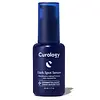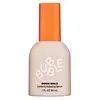What's inside
What's inside
 Key Ingredients
Key Ingredients

 Benefits
Benefits

 Concerns
Concerns

 Ingredients Side-by-side
Ingredients Side-by-side

Water
Skin ConditioningPropanediol
SolventCaprylic/Capric Triglyceride
MaskingIsodecyl Neopentanoate
EmollientNiacinamide
SmoothingGlycolic Acid
BufferingDiheptyl Succinate
EmollientTranexamic Acid
AstringentGlycerin
HumectantCapryloyl Glycerin/Sebacic Acid Copolymer
Skin ConditioningPentylene Glycol
Skin ConditioningMagnesium Aluminum Silicate
AbsorbentKojic Dipalmitate
EmollientSodium Hydroxide
BufferingXanthan Gum
EmulsifyingPolyglyceryl-10 Laurate
Skin ConditioningTocopheryl Acetate
AntioxidantTetrasodium Glutamate Diacetate
Hydroxyacetophenone
AntioxidantSclerotium Gum
Emulsion StabilisingLecithin
EmollientPolyglyceryl-10 Myristate
Skin ConditioningPullulan
Caprylyl Glycol
EmollientAloe Barbadensis Leaf Juice
Skin ConditioningGlycyrrhiza Glabra Root Extract
BleachingSodium Acetylated Hyaluronate
HumectantSodium Hyaluronate
HumectantSodium Hyaluronate Crosspolymer
HumectantHydrolyzed Sodium Hyaluronate
Skin ConditioningEthylhexylglycerin
Skin ConditioningWater, Propanediol, Caprylic/Capric Triglyceride, Isodecyl Neopentanoate, Niacinamide, Glycolic Acid, Diheptyl Succinate, Tranexamic Acid, Glycerin, Capryloyl Glycerin/Sebacic Acid Copolymer, Pentylene Glycol, Magnesium Aluminum Silicate, Kojic Dipalmitate, Sodium Hydroxide, Xanthan Gum, Polyglyceryl-10 Laurate, Tocopheryl Acetate, Tetrasodium Glutamate Diacetate, Hydroxyacetophenone, Sclerotium Gum, Lecithin, Polyglyceryl-10 Myristate, Pullulan, Caprylyl Glycol, Aloe Barbadensis Leaf Juice, Glycyrrhiza Glabra Root Extract, Sodium Acetylated Hyaluronate, Sodium Hyaluronate, Sodium Hyaluronate Crosspolymer, Hydrolyzed Sodium Hyaluronate, Ethylhexylglycerin
Water
Skin ConditioningSqualane
EmollientLactic Acid
BufferingGlycerin
HumectantCaprylic/Capric Triglyceride
MaskingSodium Hydroxide
BufferingCetearyl Olivate
Sorbitan Olivate
EmulsifyingCetearyl Alcohol
EmollientGluconolactone
Skin ConditioningPolyacrylate Crosspolymer-6
Emulsion StabilisingOpuntia Ficus-Indica Fruit Extract
Skin ConditioningGlycyrrhiza Uralensis Root Extract
Skin ConditioningAnanas Sativus Fruit Juice
Skin ConditioningCurcuma Longa Root Extract
MaskingLactobacillus Ferment
Skin ConditioningLeuconostoc/Radish Root Ferment Filtrate
AntimicrobialAzelaic Acid
BufferingMalic Acid
BufferingGlycolic Acid
BufferingCucurbita Pepo Seed Extract
Skin ConditioningDehydroxanthan Gum
Emulsion StabilisingSodium Benzoate
MaskingSodium Chloride
MaskingCitric Acid
BufferingPotassium Sorbate
PreservativeWater, Squalane, Lactic Acid, Glycerin, Caprylic/Capric Triglyceride, Sodium Hydroxide, Cetearyl Olivate, Sorbitan Olivate, Cetearyl Alcohol, Gluconolactone, Polyacrylate Crosspolymer-6, Opuntia Ficus-Indica Fruit Extract, Glycyrrhiza Uralensis Root Extract, Ananas Sativus Fruit Juice, Curcuma Longa Root Extract, Lactobacillus Ferment, Leuconostoc/Radish Root Ferment Filtrate, Azelaic Acid, Malic Acid, Glycolic Acid, Cucurbita Pepo Seed Extract, Dehydroxanthan Gum, Sodium Benzoate, Sodium Chloride, Citric Acid, Potassium Sorbate
 Reviews
Reviews

Ingredients Explained
These ingredients are found in both products.
Ingredients higher up in an ingredient list are typically present in a larger amount.
This ingredient is an emollient, solvent, and texture enhancer. It is considered a skin-softener by helping the skin prevent moisture loss.
It helps thicken a product's formula and makes it easier to spread by dissolving clumping compounds.
Caprylic Triglyceride is made by combining glycerin with coconut oil, forming a clear liquid.
While there is an assumption Caprylic Triglyceride can clog pores due to it being derived from coconut oil, there is no research supporting this.
Learn more about Caprylic/Capric TriglycerideGlycerin is already naturally found in your skin. It helps moisturize and protect your skin.
A study from 2016 found glycerin to be more effective as a humectant than AHAs and hyaluronic acid.
As a humectant, it helps the skin stay hydrated by pulling moisture to your skin. The low molecular weight of glycerin allows it to pull moisture into the deeper layers of your skin.
Hydrated skin improves your skin barrier; Your skin barrier helps protect against irritants and bacteria.
Glycerin has also been found to have antimicrobial and antiviral properties. Due to these properties, glycerin is often used in wound and burn treatments.
In cosmetics, glycerin is usually derived from plants such as soybean or palm. However, it can also be sourced from animals, such as tallow or animal fat.
This ingredient is organic, colorless, odorless, and non-toxic.
Glycerin is the name for this ingredient in American English. British English uses Glycerol/Glycerine.
Learn more about GlycerinGlycolic Acid is arguably the most famous alpha hydroxy acid (AHA) with tons of research backing its benefits.
It is found naturally in sugar cane but the form used in skincare is usually synthetic for purity and stability.
Glycolic acid removes the top layer of dead skin cells to allow newer and fresher ones to emerge.
AHAs work by breaking down the structural “glue” that holds old skin cells in place. When that buildup is gone, your skin can renew itself more efficiently.
Research also shows glycolic acid stimulates collagen production, helping to firm and thicken the skin over time. This is one of its biggest advantages over other AHAs.
Overall, glycolic acid helps with:
Fun fact: Glycolic acid boosts skin hydration by helping it produce molecules that increase hyaluronic acid naturally.
To work best, glycolic acid products should have a pH between 3-4 (that’s where exfoliation is most effective but still gentle on skin).
The pH and concentration of a product are key to its effectiveness:
It is normal to feel a slight stinging sensation when using glycolic acid. This usually fades as your skin adjusts.
Because glycolic acid has the smallest molecular size in the AHA family, it can penetrate deeper, which enhances its effectiveness but also makes it more likely to irritate sensitive skin.
If your skin is very sensitive or prone to rosacea, glycolic acid may be too strong; in that case, try milder options like lactic acid or a PHA instead.
Recent studies suggest glycolic acid might even help protect against UV damage. But don’t skip sunscreen! Freshly exfoliated skin is more sensitive to the sun.
Glycolic acid is a skincare superstar. It smooths, brightens, hydrates, and firms the skin. Unless you’re highly sensitive, it’s well worth adding to your routine.
Read more about some other popular AHA's here:
Learn more about Glycolic AcidSodium Hydroxide is also known as lye or caustic soda. It is used to adjust the pH of products; many ingredients require a specific pH to be effective.
In small amounts, sodium hydroxide is considered safe to use. However, large amounts may cause chemical burns due to its high alkaline.
Your skin has a natural pH and acid mantle. This acid mantle helps prevent harmful bacteria from breaking through. The acid mantle also helps keep your skin hydrated.
"Alkaline" refers to a high pH level. A low pH level would be considered acidic.
Learn more about Sodium HydroxideWater. It's the most common cosmetic ingredient of all. You'll usually see it at the top of ingredient lists, meaning that it makes up the largest part of the product.
So why is it so popular? Water most often acts as a solvent - this means that it helps dissolve other ingredients into the formulation.
You'll also recognize water as that liquid we all need to stay alive. If you see this, drink a glass of water. Stay hydrated!
Learn more about Water